Rye bread has a robust flavour and aroma and can often be rather dense and sold. This rye bread recipe marries flavour with texture. Scalding a flour that is low in gluten locks up the water in the flour and gelatinises it resulting in a much lighter texture.
Italian mountain bread is often also called black bread. Some versions are flavoured with cumin, fenugreek and fennel seeds. It is just as good without!
There are different types of rye flour. I often used Shipton Mill’s Light Rye, which is a lovely mix. This type is also available from Matthews Cotswold Flour and Stoates Italian rye flour both available at Ratton Pantry. Bakery Bits supply Italian Light and Wholemeal Rye flour.
It’s also a good idea to team rye with white flour to again help with the lightness of crumb. If you happen to have some sourdough starter, you can add some to the dough for added flavour.

Italian Mountain Bread Recipe
Equipment
- Cast iron pan/ Dutch oven with lid at least 23cm wide
- Digital scales
- Dough scraper
- Lame
- Stand mixer
- Large box to store dough in fridge
- Banetton or pyrex bowl and linen tea towel
Ingredients
- 350 grams white bread flour
- 115 grams rye flour
- 115 grams boiling water
- 245 millilitres water Ideal temperature 22?
- 8 grams salt
- 5 gr cumin, fenugreek and fennel seeds crushed (optional)
- 7 gr instant dried yeast
Instructions
Scalding the flour
- Boil water in a kettle and let it sit for 5 minutes.
- Add the slightly cooled water to the rye flour and mix well

- Set aside until cooled. Check temperature is less than 30°C (86°F) before using.
Autolysing the dough
- Add the white flour to a bowl. Add the cool water. Mix together and leave for 30 minutes.

Mix and Knead the dough
- Add the salt to the soaked mixture and mix well. Add the spices if using. Using a stand mixer, knead until the dough reaches between 24° and 26°C (75° to 78°F). Start on a low speed then the scalded mixture in lumps. Mix for about 5 minutes, then increase speed to medium.
- The dough should come away from the sides cleanly. Check that the dough is elastic by pulling a lump gradually apart. Checking the dough temperature is very important. This will set you up for a successful dough.
- The dough should ideally be between 24° and 26°C (75° to 78°F)
- Alternatively, knead for 10 to 15 minutes until smooth and the dough is stretchy.
First Proving at Room Temperature
- Move the dough to a large plastic box and leave it to prove for 1.5 hours at room temperature. Alternatively, put it in the fridge after 30 minutes and leave overnight.
Fold the dough
- During the first proving, fold the dough twice. Imagine that the dough in the bowl has four equal sides. Using a dough scraper, pull up each side in turn and fold towards the middle. Folding improves the structure of the dough.
Shaping the dough
- After the dough has proved shape the dough gently into a round. Leave 10 minutes.

Pre heat your oven and pan
- Pre-heat your oven to 230°C (445°F) placing your cast iron pan in the oven. Do this at least 1/2 hour before you intend to bake.
Shape and Second Prove
- Shape your loaf a second time. If your pan is circular, shape into rounds; if you pan is rectangular shape into oblongs. Place in a banetton for one hour or a pyrex bowl lined with a linen tea towel.
Prepare parchment paper
- Cut two strips of parchment paper as wide as the loaf and twice as long. You will put your dough on the parchment and place in the cast iron pan.
Transfer your dough
- After one hour, transfer the dough to the parchment paper. Place the parchment on top of the dough, then a cutting board on top and then invert it.

Score the loaf
- Using a lame or sharp knife, score the loaf horizontally. with a shallow cut on one side half way between the top of the loaf and the bottom.

Bake
- Remove the pan from the oven and remove the lid. Put the loaf into the pan and close the lid immediately.
- Place in the oven and bake for 25 minutes. Then remove the lid and bake for a further 10 minutes. Finally, bake the loaf for 5 minutes out of the pan. Let it cool before eating.

Notes
Find out more
How about taking a bread course to learn more? Scheduled, online and private courses are available.


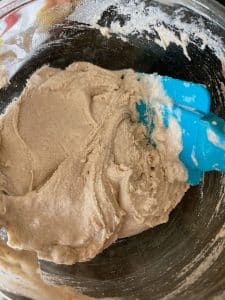
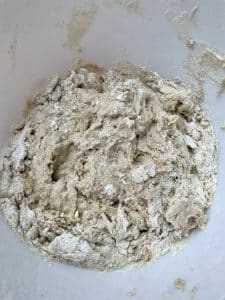
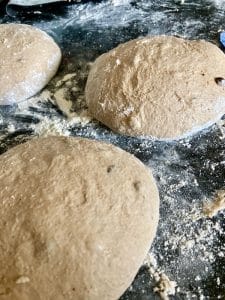
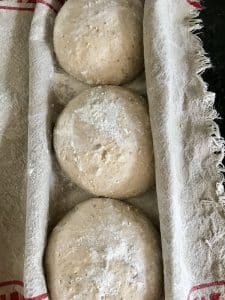
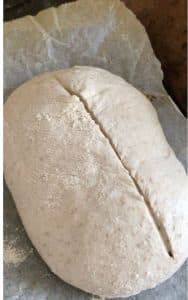
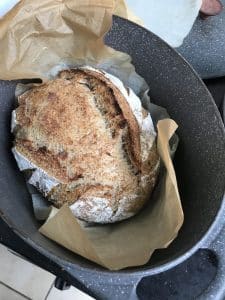




The starter here is used for flavour. You could certainly scald the flour and use it in your usual sourdough recipe. I’ve not tested it with just the starter!
Could I make this with sourdough starter and skip the yeast?